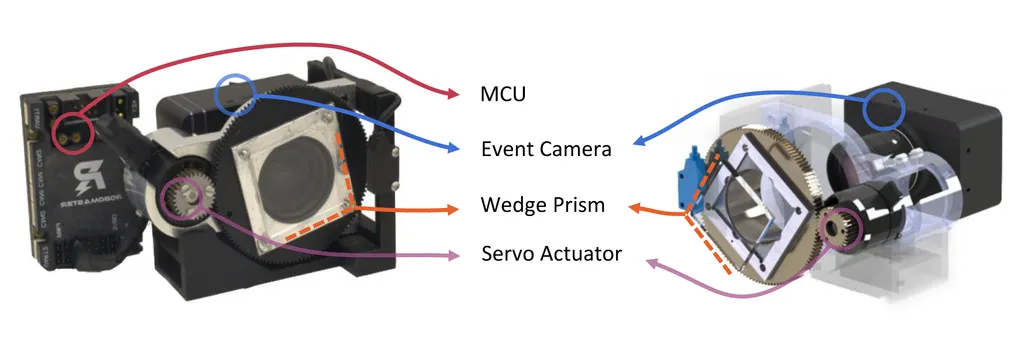- July 08, 2024
- By Georgia Jiang
A team led by University of Maryland computer scientists has invented a camera mechanism that improves how robots see and react to the world around them. Inspired by how the human eye works, its innovative camera system mimics the tiny involuntary movements used by the eye to maintain clear and stable vision.
The team’s prototyping and testing of the camera—called the Artificial Microsaccade-Enhanced Event Camera (AMI-EV)—was detailed in a paper published recently in Science Robotics.
Event cameras are a relatively new technology better at tracking moving objects than traditional cameras, but today’s event cameras struggle to capture sharp, blur-free images when a lot of motion is involved, said the paper’s lead author, Botao He, a computer science Ph.D. student at UMD.
“It’s a big problem because robots and many other technologies—such as self-driving cars—rely on accurate and timely images to react correctly to a changing environment,” He said. “So, we asked ourselves: How do humans and animals make sure their vision stays focused on a moving object?”
For He’s team, the answer was microsaccades, the minute and quick eye movements that occur without conscious thought to help the human eye focus on objects and visual textures—such as color, depth and shadowing.
“We figured that just like how our eyes need those tiny movements to stay focused, a camera could use a similar principle to capture clear and accurate images without motion-caused blurring,” He said.

The team successfully replicated microsaccades by inserting a
rotating prism inside the AMI-EV to redirect light beams captured by the
lens. The continuous rotational movement of the prism simulated the
movements naturally occurring within a human eye, allowing the camera to
stabilize the textures of a recorded object just as a human would. The
team then developed software to compensate for the prism’s movement
within the AMI-EV to consolidate stable images from the shifting lights.
Study co-author Yiannis Aloimonos, a professor of computer science at
UMD, called the team’s invention a big step forward in the realm of
robotic vision.
“Our eyes take pictures of the world around us, and those pictures are
sent to our brain, where the images are analyzed. Perception happens
through that process and that’s how we understand the world,” explained
Aloimonos, who is also director of the Computer Vision Laboratory at the
University of Maryland Institute for Advanced Computer Studies
(UMIACS). “When you’re working with robots, replace the eyes with a
camera and the brain with a computer. Better cameras mean better
perception and reactions for robots.”
The researchers also believe that their innovation could have
significant implications beyond robotics. Scientists working in
industries that rely on accurate image capture and shape detection are
constantly looking for ways to improve their cameras—and AMI-EV could be
the key solution to many of the problems they face.
With their unique features, event sensors and AMI-EV are poised to take
center stage in the realm of smart wearables, said research scientist
Cornelia Fermüller, senior author of the paper.
“They have distinct advantages over classical cameras—such as
superior performance in extreme lighting conditions, low latency and low
power consumption,” she said. “These features are ideal for virtual
reality applications, for example, where a seamless experience and the
rapid computations of head and body movements are necessary.”
In early testing, AMI-EV was able to capture and display movement
accurately in a variety of contexts, including human pulse detection and
rapidly moving shape identification. The researchers also found that
AMI-EV could capture motion in tens of thousands of frames per second,
outperforming most typically available commercial cameras, which capture
30 to 1000 frames per second on average. This smoother, more realistic
depiction of motion could prove to be pivotal in anything from creating
more immersive augmented reality experiences and better security
monitoring to improving how astronomers capture images in space.
“Our novel camera system can solve many specific problems, like helping a
self-driving car figure out what on the road is a human and what
isn’t,” Aloimonos said. “As a result, it has many applications that much
of the general public already interacts with, like autonomous driving
systems or even smartphone cameras. We believe that our novel camera
system is paving the way for more advanced and capable systems to come.”
